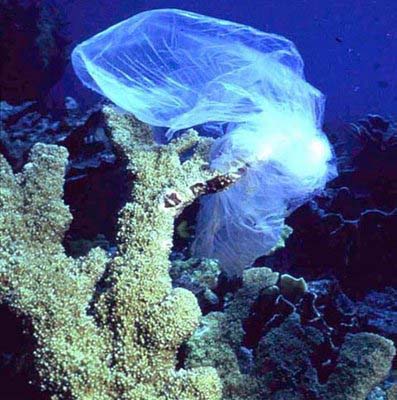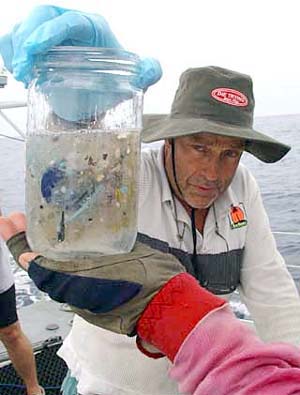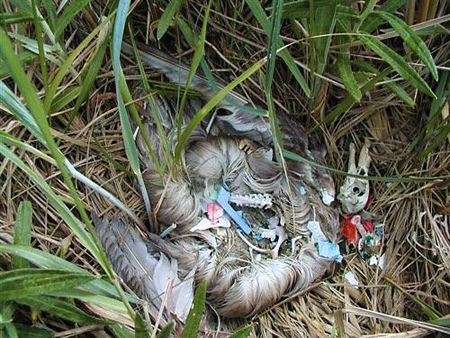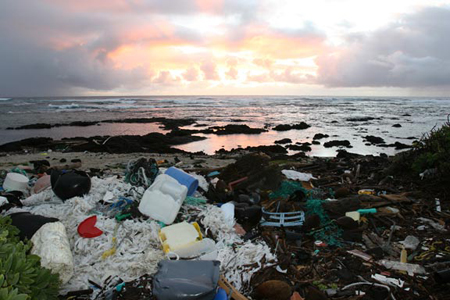Plastic Plankton
‘Everybody’s plastic, but I love plastic. I want to be plastic.’ – Andy Warhol
A “floating landfill, made up of plastic particles is swirling in a convergence zone about 30 to 40 degrees north latitude and 135 to 145 west longitude. It’s about 1,000 miles west of California and 1,000 miles north of the Hawaiian Islands — a week’s journey by boat from the nearest port. The trash collects in one area, known as the North Pacific Gyre, due to a clockwise trade wind that circulates along the Pacific Rim. While the plastic trash floats along, instead of biodegrading, it is “photodegrading,” — the sun’s UV rays turn the bottle brittle, much like they would crack the vinyl on a car roof. They break down the bottle into small pieces and, in some cases, into particles as fine as dust.
Charles Moore, the marine researcher at the Algalita Marina Research Foundation in Long Beach who has been studying and publicizing the patch for the past 10 years, said the debris — which he estimates weighs 3 million tons and covers an area twice the size of Texas — is made up mostly of fine plastic chips and is impossible to skim out of the ocean. Also, it’s undetectable by overhead satellite photos because it’s 80 percent plastic and therefore translucent. The plastic moves just beneath the surface, from one inch to depths of 300 feet, according to samples Moore collected on the most recent trip. (1)
Ironically, the debris is re-entering the oceans whence it came; the ancient plankton that once floated on Earth’s primordial sea gave rise to the petroleum now being transformed into plastic polymers. That exhumed life, our “civilized plankton,” is, in effect, competing with its natural counterparts, as well as with those life-forms that directly or indirectly feed on them. Inside the North Pacific Gyre the natural plankton is outnumbered 6 to 1 in favor of the plastic plankton. The large ratio of plastic to plankton found in this study has the potential to affect many types of biota. Most susceptible are the birds and filter feeders that focus their feeding activities on the upper portion of the water column. Many birds have been examined and found to contain small debris in their stomachs, a result of their mistaking plastic for food
Worldwide, 82 of 144 bird species examined contained small debris in their stomachs, and in many species the incidence of ingestion exceeds 80% of the individuals.
The scale of the phenomenon is astounding. Plastic debris in now the most common surface feature of the world’s oceans. Because 40 percent of the oceans are classified as subtropical gyres, a fourth of the planet’s surface area has become an accumulator of floating plastic debris. What can be done with this new class of products made specifically to defeat natural recycling? How can the dictum “In ecosystems, everything is used” be made to work with plastic? (2)




december 10th, 2008 at 19:59
that bird, it’s just like the case with sea turtles in indonesia when they eat plastic because they thought it’s a jellyfish…
maart 5th, 2009 at 00:31
You made some good points there. I did a search on the topic and found most people will agree with your blog.
maart 6th, 2009 at 07:34
I am actually doing a research paper about the topic of plastics in the oceans so I agree with everthing your saying. This really needs awareness raised because not many people know the devastating affects of plastic and why it’s terrible for everything. So thank you for taking the time to learn about this.
november 2nd, 2009 at 20:08
I will set aside blog !!!!!!!!!!!!!!!!